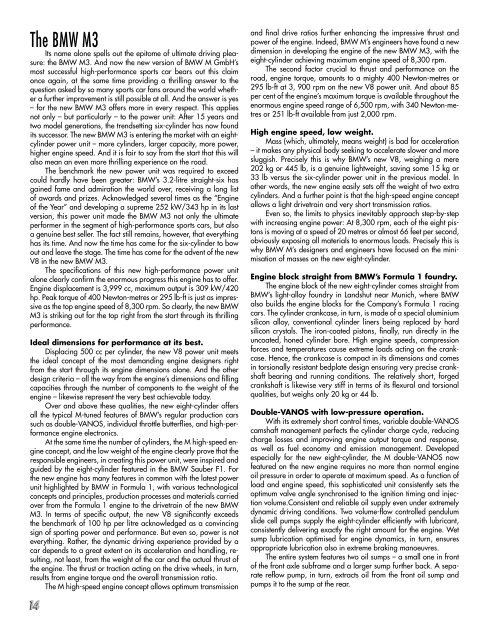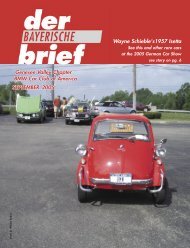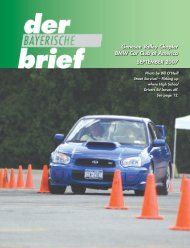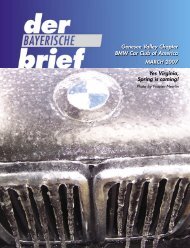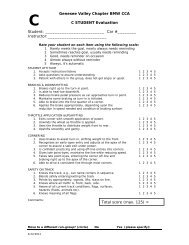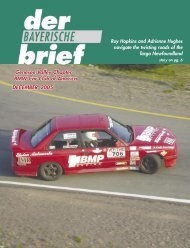Genesee Valley Chapter BMW Car Club of America JUNE 2007
Genesee Valley Chapter BMW Car Club of America JUNE 2007
Genesee Valley Chapter BMW Car Club of America JUNE 2007
You also want an ePaper? Increase the reach of your titles
YUMPU automatically turns print PDFs into web optimized ePapers that Google loves.
The <strong>BMW</strong> M3<br />
Its name alone spells out the epitome <strong>of</strong> ultimate driving pleasure:<br />
the <strong>BMW</strong> M3. And now the new version <strong>of</strong> <strong>BMW</strong> M GmbH’s<br />
most successful high-performance sports car bears out this claim<br />
once again, at the same time providing a thrilling answer to the<br />
question asked by so many sports car fans around the world whether<br />
a further improvement is still possible at all. And the answer is yes<br />
– for the new <strong>BMW</strong> M3 <strong>of</strong>fers more in every respect. This applies<br />
not only – but particularly – to the power unit: After 15 years and<br />
two model generations, the trendsetting six-cylinder has now found<br />
its successor. The new <strong>BMW</strong> M3 is entering the market with an eightcylinder<br />
power unit – more cylinders, larger capacity, more power,<br />
higher engine speed. And it is fair to say from the start that this will<br />
also mean an even more thrilling experience on the road.<br />
The benchmark the new power unit was required to exceed<br />
could hardly have been greater: <strong>BMW</strong>’s 3.2-litre straight-six has<br />
gained fame and admiration the world over, receiving a long list<br />
<strong>of</strong> awards and prizes. Acknowledged several times as the “Engine<br />
<strong>of</strong> the Year” and developing a supreme 252 kW/343 hp in its last<br />
version, this power unit made the <strong>BMW</strong> M3 not only the ultimate<br />
performer in the segment <strong>of</strong> high-performance sports cars, but also<br />
a genuine best seller. The fact still remains, however, that everything<br />
has its time. And now the time has come for the six-cylinder to bow<br />
out and leave the stage. The time has come for the advent <strong>of</strong> the new<br />
V8 in the new <strong>BMW</strong> M3.<br />
The specifi cations <strong>of</strong> this new high-performance power unit<br />
alone clearly confi rm the enormous progress this engine has to <strong>of</strong>fer.<br />
Engine displacement is 3,999 cc, maximum output is 309 kW/420<br />
hp. Peak torque <strong>of</strong> 400 Newton-metres or 295 lb-ft is just as impressive<br />
as the top engine speed <strong>of</strong> 8,300 rpm. So clearly, the new <strong>BMW</strong><br />
M3 is striking out for the top right from the start through its thrilling<br />
performance.<br />
Ideal dimensions for performance at its best.<br />
Displacing 500 cc per cylinder, the new V8 power unit meets<br />
the ideal concept <strong>of</strong> the most demanding engine designers right<br />
from the start through its engine dimensions alone. And the other<br />
design criteria – all the way from the engine’s dimensions and fi lling<br />
capacities through the number <strong>of</strong> components to the weight <strong>of</strong> the<br />
engine – likewise represent the very best achievable today.<br />
Over and above these qualities, the new eight-cylinder <strong>of</strong>fers<br />
all the typical M-tuned features <strong>of</strong> <strong>BMW</strong>’s regular production cars<br />
such as double-VANOS, individual throttle butterfl ies, and high-performance<br />
engine electronics.<br />
At the same time the number <strong>of</strong> cylinders, the M high-speed engine<br />
concept, and the low weight <strong>of</strong> the engine clearly prove that the<br />
responsible engineers, in creating this power unit, were inspired and<br />
guided by the eight-cylinder featured in the <strong>BMW</strong> Sauber F1. For<br />
the new engine has many features in common with the latest power<br />
unit highlighted by <strong>BMW</strong> in Formula 1, with various technological<br />
concepts and principles, production processes and materials carried<br />
over from the Formula 1 engine to the drivetrain <strong>of</strong> the new <strong>BMW</strong><br />
M3. In terms <strong>of</strong> specifi c output, the new V8 signifi cantly exceeds<br />
the benchmark <strong>of</strong> 100 hp per litre acknowledged as a convincing<br />
sign <strong>of</strong> sporting power and performance. But even so, power is not<br />
everything. Rather, the dynamic driving experience provided by a<br />
car depends to a great extent on its acceleration and handling, resulting,<br />
not least, from the weight <strong>of</strong> the car and the actual thrust <strong>of</strong><br />
the engine. The thrust or traction acting on the drive wheels, in turn,<br />
results from engine torque and the overall transmission ratio.<br />
The M high-speed engine concept allows optimum transmission<br />
14<br />
and fi nal drive ratios further enhancing the impressive thrust and<br />
power <strong>of</strong> the engine. Indeed, <strong>BMW</strong> M’s engineers have found a new<br />
dimension in developing the engine <strong>of</strong> the new <strong>BMW</strong> M3, with the<br />
eight-cylinder achieving maximum engine speed <strong>of</strong> 8,300 rpm.<br />
The second factor crucial to thrust and performance on the<br />
road, engine torque, amounts to a mighty 400 Newton-metres or<br />
295 lb-ft at 3, 900 rpm on the new V8 power unit. And about 85<br />
per cent <strong>of</strong> the engine’s maximum torque is available throughout the<br />
enormous engine speed range <strong>of</strong> 6,500 rpm, with 340 Newton-metres<br />
or 251 lb-ft available from just 2,000 rpm.<br />
High engine speed, low weight.<br />
Mass (which, ultimately, means weight) is bad for acceleration<br />
– it makes any physical body seeking to accelerate slower and more<br />
sluggish. Precisely this is why <strong>BMW</strong>’s new V8, weighing a mere<br />
202 kg or 445 lb, is a genuine lightweight, saving some 15 kg or<br />
33 lb versus the six-cylinder power unit in the previous model. In<br />
other words, the new engine easily sets <strong>of</strong>f the weight <strong>of</strong> two extra<br />
cylinders. And a further point is that the high-speed engine concept<br />
allows a light drivetrain and very short transmission ratios.<br />
Even so, the limits to physics inevitably approach step-by-step<br />
with increasing engine power: At 8,300 rpm, each <strong>of</strong> the eight pistons<br />
is moving at a speed <strong>of</strong> 20 metres or almost 66 feet per second,<br />
obviously exposing all materials to enormous loads. Precisely this is<br />
why <strong>BMW</strong> M’s designers and engineers have focused on the minimisation<br />
<strong>of</strong> masses on the new eight-cylinder.<br />
Engine block straight from <strong>BMW</strong>’s Formula 1 foundry.<br />
The engine block <strong>of</strong> the new eight-cylinder comes straight from<br />
<strong>BMW</strong>’s light-alloy foundry in Landshut near Munich, where <strong>BMW</strong><br />
also builds the engine blocks for the Company’s Formula 1 racing<br />
cars. The cylinder crankcase, in turn, is made <strong>of</strong> a special aluminium<br />
silicon alloy, conventional cylinder liners being replaced by hard<br />
silicon crystals. The iron-coated pistons, fi nally, run directly in the<br />
uncoated, honed cylinder bore. High engine speeds, compression<br />
forces and temperatures cause extreme loads acting on the crankcase.<br />
Hence, the crankcase is compact in its dimensions and comes<br />
in torsionally resistant bedplate design ensuring very precise crankshaft<br />
bearing and running conditions. The relatively short, forged<br />
crankshaft is likewise very stiff in terms <strong>of</strong> its fl exural and torsional<br />
qualities, but weighs only 20 kg or 44 lb.<br />
Double-VANOS with low-pressure operation.<br />
With its extremely short control times, variable double-VANOS<br />
camshaft management perfects the cylinder charge cycle, reducing<br />
charge losses and improving engine output torque and response,<br />
as well as fuel economy and emission management. Developed<br />
especially for the new eight-cylinder, the M double-VANOS now<br />
featured on the new engine requires no more than normal engine<br />
oil pressure in order to operate at maximum speed. As a function <strong>of</strong><br />
load and engine speed, this sophisticated unit consistently sets the<br />
optimum valve angle synchronised to the ignition timing and injection<br />
volume.Consistent and reliable oil supply even under extremely<br />
dynamic driving conditions. Two volume-fl ow controlled pendulum<br />
slide cell pumps supply the eight-cylinder effi ciently with lubricant,<br />
consistently delivering exactly the right amount for the engine. Wet<br />
sump lubrication optimised for engine dynamics, in turn, ensures<br />
appropriate lubrication also in extreme braking manoeuvres.<br />
The entire system features two oil sumps – a small one in front<br />
<strong>of</strong> the front axle subframe and a larger sump further back. A separate<br />
refl ow pump, in turn, extracts oil from the front oil sump and<br />
pumps it to the sump at the rear.


